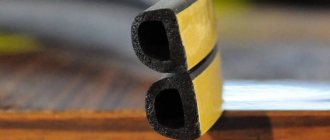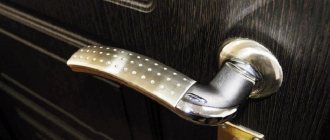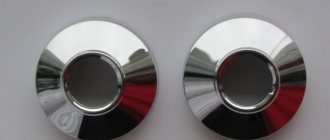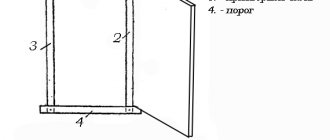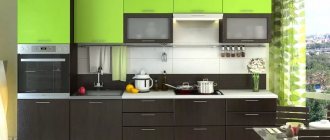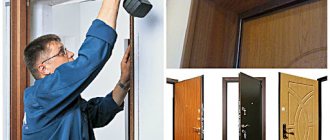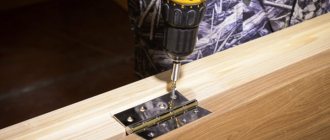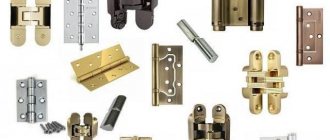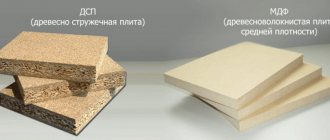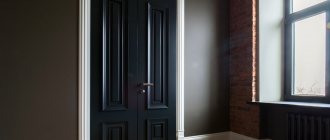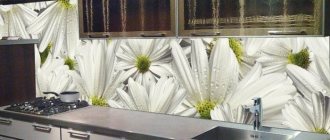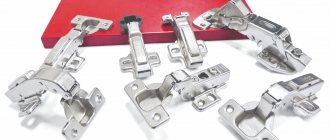Metal doors with MDF panels look very solid and have high levels of heat and sound insulation. A variety of color and milling options allows you to have a unique design and choose a coating that matches the renovation in the hallway, as well as the general facade of the building, in the case of a private house. But due to moisture, sun or mechanical damage, the lining can lose its attractive appearance and even contribute to the deterioration of the metal if water begins to penetrate between the wooden element and the steel sheet. You can replace the MDF panel on the front door with your own hands, for which you will need a screwdriver with crowns and bits, which will do all the work.
Choosing the right replacement panel
Replacing a decorative panel is the best way to give your doors a new look at a low cost. This can be done not only in the global situations described above, but also simply to change the interior in the hallway or a new design at the entrance outside. To easily replace the inner panel of a metal door or its outer plate, you need to select a new analogue with the exact dimensions.
It is important to take three criteria into account:
- overlay height;
- width;
- thickness of the wooden element.
If the panel is selected smaller, then the protruding metal strips will spoil the look. The enlarged overlay may not fit into the box when rebated, which will require time-consuming rework, which is difficult at home. Insufficient thickness can lead to the panel hanging, and its excess can lead to the impossibility of inserting into the guides.
To accurately take measurements, an inexperienced owner will need to dismantle the cover and measure all three indicators with a tape measure. You need to order an MDF panel that is already cut to size and has a treated edge to prevent it from crumbling or absorbing moisture. In the case of a private house, you need an overlay with Vinorit film, which will not fade in the sun and will protect the canvas from precipitation.
A few words about finishing slopes
Slopes are the part of the wall that frames doors or windows; accordingly, until the slopes are made, the door lining cannot be considered complete. In this case, experts identify 4 common options for facing slopes.
- Plastering is considered the most reliable and durable. Such a slope will last for decades, but not everyone can do plastering work, plus it is a rather dirty process;
Plastering slopes requires certain skills.
- Covering slopes with plasterboard is considered no less reliable. GKL sheets can be either mounted on the sheathing or glued to a special building mixture, but after installation the drywall must be puttied;
Scheme of covering a slope with gypsum board.
- Another popular way of finishing door slopes is installation on the sheathing. It’s simple, you just put a sheathing on the slope, and on the sheathing you can attach everything you see fit – plastic, MDF, gypsum board, plywood, lining, etc.
Option for sheathing for door slopes.
- But the most popular option now are telescopic slopes made of MDF. They are a kind of constructor. Depending on the thickness of the wall, the width of the additional strip is selected and the entire structure is installed in a couple of hours, the only problem is that telescopic slopes are much more expensive than others.
Diagram of a telescopic door slope.
You can find out how slopes are made in practice “here”.
https://youtu.be/0ukuhbxYSZ0
Replacing the MDF panel in the case of guide corners
A common way to attach MDF overlays to metal doors is using corners that act as guides. They are performed by bending a sheet of solid iron using hydraulic equipment. In this case, it is necessary to find a detachable end, fixed with screws, which will provide access to the exit. Replacing the front door panel is carried out by moving the wooden element out along the guides. Often the point of disconnection is the lock side or bottom of the sash.
To replace with this type of mounting, perform the following steps:
- If the detachable edge is located at the bottom, then the fabric is removed from the hinges. With a lateral position, manipulations are carried out on the open sash.
- The peephole, handle and lining for the lock holes are removed from the door.
- Use a screwdriver to unscrew the screws holding the metal side.
- The panel extends outward over the edge.
- The place is cleared of dust and debris. It is important to remove anything that could get on the bottom edge and interfere with the installation of the new panel. If there is rust, it is removed with abrasive means (emery wheels on a grinder or drill).
- An overlay corresponding to the dimensions of the previous one is placed on the lower corner. Slightly bending it in the middle will allow you to insert the upper part. Having knocked it from the side, it rests against the opposite side.
- After precise placement, holes for the peephole and handle are drilled with a screwdriver, and a hole for the keyhole is created with a crown. The closing stop is installed last.
How to upholster a wooden door
Upholstery of wooden entrance doors will extend the life of the wood and prevent it from drying out. In the process of work, the following materials are used:
When choosing a material, take into account which direction the door opens. The method of working with sealing rollers and fastening the upholstery sides depends on this:
- opens outwards (the rollers are fixed to the ends of the door frame);
- opens inward (the rollers are attached to the door frame).
To make the upholstery process quick and convenient, the craftsman needs to prepare a door upholstery kit in advance: material, insulation (batting, padding polyester, isolon, foam rubber at least 2 cm thick), repair tools (special nails, tape measure, scissors, hammer, screwdriver, stapler) . For 1 m² of area you will need 50 g of construction nails and 75 g of decorative nails.
A door upholstery kit with foam rubber will provide not only better sound insulation, but will also additionally insulate the room.
Entrance door trim: operating algorithm
- Measuring the door leaf, preparing it and segments for masking the edges. Measurements are taken with a tape measure. To create blanks, two strips equal to the width of the door and one equal to the length are cut out of the material. The width in both versions is 14 cm. Then they cut out the canvas around the perimeter 10 cm larger than the door measurements. It needs to be removed from its hinges and the fittings removed.
- Removing old material, cleaning the surface (with special removers, a spatula).
- Insulation is placed on the door leaf, the upholstery material is secured with decorative nails and special tape for the edges. First, fix the side segments with nails with the edge (wrong side out). The lower part is nailed no less than 2 cm from the edge so that the material does not rub through too quickly. Each step of the sheet covering is 10 cm.
- To provide additional noise and thermal insulation, in addition to the standard upholstery, it is recommended to install a sealing bead around the perimeter of the box, an additional layer of foam rubber, synthetic padding on both sides. Sealing rollers are placed on the side segments of the material, the edges are tightly wrapped inward. At the edge of the fold they are attached with decorative nails. If the product opens inward, the rollers are attached to the ends of the door frame.
- They make holes for locks and eyes, bend the edges and fasten them with nails.
- The product is hung on loops.
The upholstery is stretched so that folds and wrinkles do not form. To do this, the material is fixed with a nail, first from the top, then from the bottom, carefully straightening it, and only then the side part is attached.
For decoration, silk cord and wire are used, and special nails are used in the form of a pattern.
If plastic (fabric) is used, then a different technology is used. The main tool in the process of upholstery with this material is rectangular profile strips with a special slot. A decorative baguette frame is inserted into it and its coals are sawed off at 45°. The frame is fixed with nails (7-10 cm indentation), insulation is placed and covered with plastic, which is secured with nails at a pitch of 4 mm.
Replacing an MDF panel in case of fastening with self-tapping screws
If the doors do not have curved sides for installing the lining, then it is attached with self-tapping screws. The action is performed either through wood into metal, or from the side of an iron sheet into a wooden part. Replacing an MDF panel on the front door in this case requires finding a mounting method and dismantling it.
If plastic circles are visible around the perimeter of the lining, then these are caps covering the place of fixation. They are pryed off with a knife, and the screws are unscrewed with a screwdriver. In order not to remove the canvas from the hinges, you need to place a stop under the wooden element. Installing a new slab is done in the same way, but you must first mark the attachment points by connecting two wooden elements together and drawing dots with a pencil through the holes. Drilling is carried out exactly according to the marks and with a diameter corresponding to the cross-section of the screws. The distance of 5 mm from the surface should be expanded with another drill to make it possible to recess the screw heads and install plugs.
If no traces of installation are visible on the surface, then the external MDF lining was attached from the inside. To do this you will have to disassemble the canvas. The handles, peephole and lock plates are removed. At the end of the sash there will be screws holding the inner sheet of wood. By unscrewing them we get access to the cavity where it is necessary to remove the insulation layer. Replacing an MDF panel on a metal door is the most labor-intensive here, because you will need to disconnect the outer plate, unscrewing all the fixing elements around the perimeter and installing them back into the new trim. After which you need to return the filler and other parts to their place.
offers to buy various metal doors with beautiful finishing with MDF panels. But if the existing canvas only needs to replace the lining, then you can order this service. There are different thicknesses of MDF boards, colors and milling methods available for selection.
Door upholstery material – should I choose dermantine or vinyl leatherette?
First of all, let's understand the concepts of dermantine and vinyl artificial leather. Both materials are leather substitutes. Outwardly they are similar. They have a similar manufacturing process.
Dermantin (from the Greek dermatinos - leather) is a cotton fabric with a nitrocellulose coating. Hence its second name: nitro artificial leather. The coating can be applied to one or both sides. This is the cheapest finishing material, the price of which starts from 200 rubles/m.p.
Dermantin began to be widely used in the USSR in the 30s of the last century, when the need for a cheap finishing material arose. It quickly gained popularity - book binding, leather goods, furniture upholstery, table tops and much more were made from it.
But dermantin did not have high aesthetic qualities, and rather quickly wore out and crumbled, and its elasticity left much to be desired. Therefore, knitted fabrics and highly stretchable non-woven materials and fibers began to be used as a base, and more resistant polymers were used as coatings: polyvinyl chloride (PVC) and polyacetate. So, by the end of the 1960s, dermantine was replaced by a more modern analogue - vinyl leather.
Vinyl leather has practically no disadvantages of its predecessor - dermantine, significantly surpasses it in all respects and is very similar in appearance to natural leather.
The production technology of this material consists of three stages:
- preparing the base
- polymer coating treatment
- finishing.
The quality and properties of the fibrous base affect the strength and stretchability, the ability to drape, and the quality of vinyl leatherette in general. To increase density and strength, the fibrous base is impregnated with solutions, dispersions and polymer melts using various technologies and equipment. The finished fabric undergoes final processing: the necessary patterns are applied and the texture is created.
Main characteristics of vinyl leather:
- pleasant to the touch texture, attractive appearance;
- resistant to mechanical damage, stretching, bending;
- wear-resistant;
- resistant to temperature changes;
- has low flammability;
- resistant to stains and easy to maintain, easy to clean with ordinary detergents;
- able to retain heat;
- not subject to rotting due to the action of microorganisms;
- moisture resistant.
Perhaps, only two disadvantages of vinyl leather can be noted - it is very easy to cut or seriously scratch with a sharp object. At the same time, it cannot be repaired and a separate part cannot be replaced; a complete replacement of the door trim will be required (well, unless, of course, you don’t care what the door will look like, you can stick a patch on it). Low resistance to ultraviolet radiation - it becomes very hard, cracks and fades. Therefore, it is not recommended to use it for upholstering an entrance door facing directly onto the street. For this purpose, it is better to use eco-leather (but this is no longer a budget option).
Modern vinyl artificial leather has many colors, shades and surface textures:
- smooth - shiny and matte, there is even a metallic effect;
- porous;
- structured, imitating different types of leather (snake, crocodile, etc.).
Fig. 2 Vinyl leather options
This determines its popularity when choosing material for door upholstery.
Thus, both materials are very similar and at the same time quite different in characteristics. By the way, it is still correct to say and write leatherette, but somehow this word sounds dissonant in Russian (not my personal opinion - many people think so). In addition, dermantine in its pure form as it was in the last century has not been produced for a long time. But it so happened historically that the word “dermantine” has firmly entered our everyday life and few people use the concept of vinyl artificial leather. Therefore, when purchasing on your own, be guided by the price tag, specify what kind of material is meant, because the properties and prices are very different: even if it says “dermantine”, keep in mind if the price per linear meter is 600-800 rubles. and more, it is vinyl leather.
So, we have sorted out the concepts, but, with your permission, I will still use the word “dermantin” further in the text (to be closer to the people, so to speak).
Preparing for work
Replacing the old upholstery will not only affect the aesthetics of the doorway, but will also improve the insulating qualities. The quality of the upholstery determines the presence of drafts and foreign odors in the house. Replacement will not be a difficult task if you have a home craftsman's tool and the necessary materials at hand. Buy the required amount of upholstery fabric, insulation (foam rubber or mineral wool) and decorative nails. You will also need a small hammer. Now you are ready to restore the outdated door structure with your own hands.
Pros and cons of MDF overlays
Innovative, non-standard technologies supply manufacturers with unique materials that give doors a “second life” - natural wood, plastic and MDF panels.
The advantages of the latter are:
The advantages are complemented by ordering products comprehensively through an electronic catalog. There are disadvantages that often manifest themselves in a number of ways:
After weighing the pros and cons, find the optimal point. This will become the basis for correct and thoughtful financial investments.
Underwater rocks
- When stretching the material, you need to carefully ensure that it is fixed correctly, without wrinkles or folds. If you have no experience in this kind of work, you can spoil the material or carry out this stage poorly.
- There is no need to insulate with popular materials (paper, felt). They do not retain heat well and encourage pests.
- The cutouts for the peephole and lock should be smaller than the fittings.
- When working with the upholstery of a metal product, it is important to ensure that the material of the inner and outer upholstery does not overlap at the gluing points. Otherwise, the fasteners will be of poor quality.
- It is better not to use rubber gaskets to seal joints; this will prevent the door from closing properly.
Upholstering the front door is much cheaper and easier than replacing it, and the alternative in the form of installing decorative panels from MFD is not cheap (about 3,500 without a specialist visiting for measurements). Another advantage of this design is insulation and positive changes in the interior.
Do-it-yourself door upholstery will save money and be confident in the quality of the work performed.
Source: misterdver.ru
Other options
In both composite and iron structures, upholstery fabric and wood are not the only materials that can be used to upholster a metal entrance door. There are several other options that are used somewhat less frequently in practice, but allow for beautiful and neat finishing.
Wood veneer
Veneer is thin slices of wood that are removed using a planer. The cut can be very thin - just a few millimeters. Thanks to this, veneer can be laid out in a pattern and even formed into a mosaic. If you lay elements overlapping, you can design three-dimensional parts. The veneered structure should be treated with care, avoid exposure to moisture and direct sunlight.
